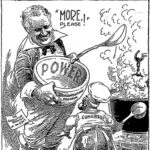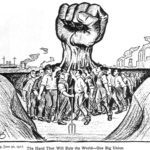Getting Over the New Deal with Janus

The real lesson of Janus is that the Court is no longer infatuated with the NLRA and its doctrinal baggage
This essay appeared in Law & Liberty on March 13, 2019 (here). Thanks to these sites for the links: How Appealing, Instapundit (here), SCOTUSblog (here), Real Clear Policy (here), and (even) The Bulwark.
Last year’s decision in Janus v. AFSCME (2018) is properly seen as a landmark ruling in the area of compelled speech (e.g., here and here), but it is more than that. By overruling Abood v. Detroit Board of Education (1977), the Court in Janus acknowledged that its extension of private-sector labor law precedents concerning union-security clauses to the public sector was erroneous. I have previously written about “the road to Abood” (here and here), and explained why the Court’s poorly-reasoned decisions under the National Labor Relations Act (NLRA) should not govern arrangements involving government employees. Justice Alito, who authored Janus and the decisions leading up to it, scathingly dissected the Court’s NLRA precedents, most of which were issued during the heyday of the Warren Court.
By exposing the shoddy doctrinal foundation of Abood, Alito was able to clean the Augean stables of the Court’s compelled speech jurisprudence, but the Court simultaneously signaled that its decades-old love affair with the NLRA—a New Deal-era statute that codified class struggle–is finally over. In hindsight, we can see that Abood was the high-water mark of the Court’s dubious infatuation with the NLRA and its Marxian notions of economic warfare between capital and labor. After 1977, the spark of magic that once animated the Court’s approach to labor law seemed to fade. The romance soured. The bloom came off the rose. What happened? How did the Court fall out of love with one of the New Deal’s most iconic statutes, the NLRA?

The shift began in the 1980s, when heavily-unionized industries in the U.S. began to fail, due to excessive labor costs and burdensome work rules, exacerbated in some cases by global competition. Employers’ inability to compete—triggering plant closings, shutdowns, and other major business decisions–came to the Court in the form of First National Maintenance v. NLRB [1] in 1981. To the chagrin of organized labor, the Court held that employers have no “duty to bargain” with the union over such decisions pursuant to the NLRA. A second–and more momentous–sign came a few years later, in the Bildisco case [2], in which the Court allowed unionized employers to “reject” union contracts under Chapter 11 of the Bankruptcy Code. The justices unanimously rebuffed the unions’ legal position, including the arch-liberal Justices Brennan and Marshall. The decision shocked and angered organized labor.
Although Congress subsequently limited the scope of Bildisco by amending the Bankruptcy Code, University of Michigan law professor James J. White saw the decision as a turning point for the Court. In an important article, White suggested that the Bildisco decision indicated an attitudinal change by the Court; labor unions no longer enjoyed the privileged status they had enjoyed for 45 years:
If that is the basis for the Bildisco case, it has a meaning for every case involving union rights that comes before the Supreme Court in the foreseeable future. It means that their arguments will be met with a skepticism formerly reserved for the rich and selfish, not with the traditional sympathy accorded the working man. It means that the assertion that the union speaks for and correctly represents the individual’s interest will now be open to question. (Emphasis added.)
As I have said elsewhere, the Supreme Court takes important cues from the legal academy. As the NLRA approached its 50th anniversary in 1985, the legal scholars who used to venerate the institution of collective bargaining—many of them New Dealers themselves–began to retire or moved on to other fields. Labor law, once a serious subject taught by prominent academics such as Archibald Cox and Derek Bok at Harvard and Robert Gorman at Penn, became the province of transparently-partisan union advocates (or younger, ideologically-driven progressives), and, as union membership continued to decline in the private sector, eventually became moribund. When Yale Law School held a symposium in 1983 on “The Legacy of the New Deal: Problems and Possibilities in the Administrative State,” it invited Richard Epstein, an outspoken critic of the NLRA, as the main speaker. [3] Yale’s own Julius Getman, a liberal defender of the NLRA, was aghast at Epstein’s iconoclasm, [4] but Epstein’s selection emphasized organized labor’s fall from grace.

Perhaps “plummet” would be a more accurate term. As I noted in Law & Liberty a couple of years ago,
The portion of the private sector workforce belonging to labor unions has plummeted from a peak of around 35 percent in the mid-1950s to less than seven percent in 2015—the lowest percentage since the National Labor Relations Act was passed. That is, Big Labor’s market share has declined to less than 20 percent of what it was at its zenith.
Today, private-sector unionization has declined to a few industries and regions of the country, and the “labor movement” consists in large part of public employee unions, which are subject to state law. Public-sector collective bargaining is not amenable to uniform national pedagogy, unlike the NLRA. Labor law, no longer emphasized at most law schools, has become a specialty practice area, similar to admiralty, and is typically combined with related disciplines such as employment discrimination and employment law.
For the NLRA, the thrill is gone. The sex appeal of “industrial democracy” has not aged well. Private-sector unions came to be regarded (in Professor White’s words) “as mature, powerful American institutions…possessing the same qualities as other powerful (and therefore suspect) American institutions, such as corporations and governmental agencies.”
Unionized public-sector employees—many of whom are teachers, police officers, and firefighters—do not evoke the same proletarian appeal as coal miners, factory workers, and manual laborers. In quasi-Marxian terms, the NLRA regarded collective bargaining as necessary to correct the inherent “inequality of bargaining power” between capital and labor; individual workers were thought to be at an economic disadvantage vis-à-vis corporate employers. Government employees are not generally viewed as “oppressed” or “exploited,” and are often considered to be a special interest group in their own right.
Accordingly, when one goes back and reviews the Supreme Court decisions upholding the constitutionality of the NLRA [5], enforcing the collectivist doctrine of “exclusive representation” [6], and inventing make-weight doctrines such as the “duty of fair representation,” [7] agency shop, and rebate procedures [8] to ameliorate the inherent abuses of forced unionization, one sees a willful suspension of disbelief typical of a smitten suitor. The Supreme Court precedents that Justice Alito eviscerated in Janus—Hanson being just one example—are, unfortunately, the judicial equivalent of blowing kisses to the NLRA. Like reading old love letters once the romance is over, they seem mawkish—even embarrassingly puerile. The human temptation is to eliminate reminders of past mistakes. [9]
For this reason, Janus is a bellwether of doctrinal change. Overruling Abood portends a re-evaluation of all NLRA-derived concepts (including “exclusive representation”) in the public sector, as well as the extension of compelled speech challenges to other government-mandated payments (such as the unified bar). The Court’s estrangement with quasi-socialist New Deal concepts could have far-reaching consequences in the years to come, as the administrative state undergoes renewed scrutiny.
[1] 452 U.S. 666 (1981).
[2] NLRB v. Bildisco & Bildisco, 465 U.S. 513 (1984).
[3] See Richard Epstein, “A Common Law for Labor Relations: A Critique of the New Deal Labor Legislation,” 92 Yale L.J. 1357 (1983).
[4] Julius Getman, “The Common Law, Labor Law, and Reality: A Response to Professor Epstein,” 92 Yale L.J. 1415 (1983).
[5] NLRB v. Jones & Laughlin Steel Corp., 301 U.S. 1 (1937).
[6] J.I. Case Co. v. NLRB, 321 U.S. 332 (1944).
[7] Steel v. Louisville & Nashville Railroad Co., 323 U.S. 192 (1944).
[8] International Association of Machinists v. Street, 367 U.S. 740 (1961).
[9] In country music terms, think of Jamey Johnson’s break-up song, Mowin’ Down the Roses.

































